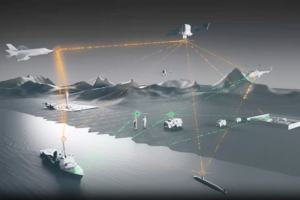When most people think of drone delivery, they imagine a futuristic landscape filled with buzzing devices dropping off packages from global online retailers. But for Beth Flippo, CEO of Drone Express, the future of drone delivery is about going back to the basics.
She believes drone delivery can empower local businesses, and provide a service that brings us closer to the way things used to be: shopping local, supporting our neighborhood stores, and getting back to the kitchen table with fresher, higher-quality goods.
At The Drone Girl, we had the chance to sit down with Beth Flippo to talk about Drone Express, the future of drone delivery, and what it’s like being a CEO in a male-dominated field.
Do you know an awesome drone girl I should profile? Contact me here.
Caroline Dobrez: Can you tell our readers a little bit about yourself and what led you to drones?
Beth Flippo: I’m an engineer by trade—an embedded software developer. My background is in electronics and computer science, which is where embedded systems come into play. I’ve always loved working with mobile platforms and building custom operating systems for small circuit boards. I like to think of myself as a bit of a modern-day Frankenstein, bringing these little boards to life.
I actually got into drones almost by accident. My family’s business was in defense contracting, and we developed a wireless mesh network to help drones communicate with each other in the sky. We initially thought the military would be interested, but instead, drone delivery companies started reaching out. They needed a more affordable solution, and we realized we could fill that gap in the market.

Caroline Dobrez: I imagine this is how Drone Express came to be.
Beth Flippo: Absolutely. After we saw the interest in our mesh network, I started focusing on grocery chains as potential customers. Kroger stood out to me because their stores are right in the heart of neighborhoods—perfect for drone delivery. After about a year of persistence, we secured a contract with them. From there, things moved quickly. We went straight to the FAA to get the necessary certifications, which was a bold move at the time. Now, we’re one of only six companies in the U.S. with a Part 135 air carrier license, which allows us to legally fly drones for delivery.
We’ve also been growing our team, which is still small but mighty—23 people who each do the job of ten. After Kroger, we easily attracted other big names like Papa John’s. Retailers are really excited about drone delivery because it gives them a competitive edge over online retailers.
CD: That’s impressive. So, where are you currently operating, and what’s next for Drone Express?
BF: We’re about to go live in Winston-Salem, North Carolina. We’ve built a new marketplace app where consumers can shop from local merchants, similar to Instacart or DoorDash, but with drones delivering the goods. What’s amazing about drone delivery is how much cheaper and faster it is compared to traditional delivery methods. We’re offering unlimited deliveries for $5.99 a month with no minimum order quantity, which is a game-changer for local businesses.
CD: What else sets Drone Express apart from other drone delivery services?
BF: Our FAA certification definitely sets us apart, but what really makes us unique is our flexibility. Unlike Amazon or Google, we’re small and nimble. We can pivot quickly to meet demand, and our marketplace model is unique in the industry. We’re not just lining up behind big names like Walmart; we’re creating something new that’s driven by consumer demand.

CD: Looking ahead, what do you see as the biggest opportunities and challenges for the drone delivery industry?
BF: The biggest opportunity is the shift in consumer behavior. The demand for drone delivery is there, especially after the pandemic. The biggest challenge, though, is overcoming safety concerns. People are still nervous about drones flying overhead, but our goal is to demonstrate that drones can be just as safe, if not safer, than traditional aviation.
But what excites me most about drone delivery is how it can bring us back to a simpler, more localized way of shopping. Imagine being able to order fresh meat from your local butcher, cheese from the neighborhood dairy shop, or bread from the bakery down the street—and have it delivered within minutes. It’s about hyper-local commerce, something we’ve lost with the rise of online shopping giants like Amazon.
Drone delivery can help revive Main Street by giving small businesses a cost-effective way to compete, offering faster delivery times without the massive infrastructure of big warehouses and fleets of trucks. This is about more than convenience; it’s about strengthening communities and keeping our money where it matters—supporting local jobs, local economies, and local traditions.
CD: It’s clear you’re passionate about supporting local businesses. Can you talk a little about the technology behind Drone Express?
BF: Our technology is pretty advanced. We’ve developed a mesh network that allows our drones to communicate and coordinate with each other in real-time, without needing to connect back to a central hub. We’re also using AI, in partnership with Microsoft, to make our drones smarter. They can analyze their surroundings and determine the safest place to drop a package, which is a huge leap forward in terms of safety and efficiency.
CD: It’s exciting to think about how this technology could reshape our everyday lives. I also want to touch on your experience as a female CEO in a male-dominated industry. How do you lead, and what’s important to you in this space?
BF: Being a female CEO in both tech and aviation is unique. Early in my career, I felt the pressure to blend in and act like one of the guys. But when I started Drone Express, I decided to embrace my femininity. Our office even has a pink couch! I’ve made it a point to promote women within the company and create a supportive environment. I believe the future is female, and I’m proud to lead a company that reflects that.
CD: I love that. Finally, what advice would you give to young women who are looking to enter the drone, tech, or aviation industries?
BF: Don’t be afraid to be the only woman in the room. It can be intimidating, but it’s worth it. My career path started with a programming class in high school that I initially didn’t want to take, but a teacher encouraged me to try it out. That one decision changed my life. So, lean into those uncomfortable spaces and know that you’re something special if you can thrive in them.
You can connect with Beth Flippo on Linkedin. Do you know an awesome drone girl I should profile? Contact me here.
The post Beth Flippo’s vision: how the CEO of Drone Express is reshaping the future of delivery appeared first on The Drone Girl.











